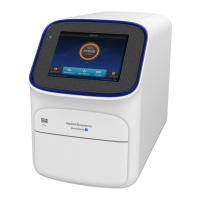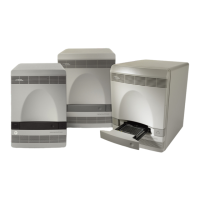Table 8 RNase P test troubleshooting
Problem/symptom Possible cause Action
RNase P plate or array card
verification run failed.
• Contamination
• Defective seal
• Inaccurate fluid transfer during
plate or array card
manufacturing
• Insufficient centrifugation
CAUTION! PHYSIC
AL INJURY HAZARD. During operation, the
sample block can reach 100℃. Before removing the plate or array
card, wait until the block reaches room temperature.
1. Unl
oad the RNase P plate or array card from the instrument.
2. Hold the plate or array card up to a light source, and confirm that all
wells contain the same volume of fluid.
If there are differences in fluid volumes, check the heat seal of the
wells with lower volumes for signs of damage or evaporation.
Compare the position of the wells that have lower volumes with the
outliers that you have removed from the plate or array card. If the well
positions coincide, the heat seal on the consumable may be defective,
resulting in the evaporation of the associated samples.
3. Contact Thermo Fisher Scientific to order a replacement RNase P
plate or array card. If the replacement consumable fails, contact
Technical Support for assistance.
Instrument does not eject the RNase
P plate or array card (the
consumable is stuck within the
instrument).
Adhesive cover may have adhered
the plate or array card to the heated
cover within the instrument.
Remove the plate or array card from the instrument as explained in
“Remove a plate stuck within the instrument“ on page 81.
Negative control well displays the
AMPNC flag, indicating that the well
amplified.
Contamination in one or more PCR
reaction components contained in
the negative control well.
Contact Thermo Fisher Scientific to order a replacement RNase P plate or
array card kit. If the replacement RNase P consumable fails, contact
Technical Support for assistance.
Well displays the BADROX
™
flag,
indicating that the passive reference
signal is unacceptable for the
normalization of the reporter dye
signal.
• Droplets on the sides of the
wells
• Improper sealing or seal leaks
• Condensation on the plate or
array card
If a well is flagged, confirm the results:
1. Select the flagged well(s) in the plate layout or well table.
2. View the amplification plot (R
n
vs. Cycle), and review the data in the C
t
region for abnormalities.
3. Examine the plate or array card to check for condensation and/or
inconsistent reaction volumes.
4. Contact Thermo Fisher Scientific to order a replacement RNase P
plate or array card. Repeat the test and make sure to properly
centrifuge the RNase P consumable. If the replacement RNase P plate
or array card fails, contact Technical Support for assistance.
Chapter 2 Calibrate the instrument
Troubleshooting
2
78
QuantStudio
™
6 and 7 Flex Real-Time PCR Systems v1.6 Maintenance and Administration Guide
